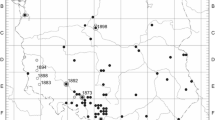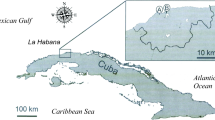Abstract
The investigated problem was whether and to what an extent the elements of weather conditions were associated with changes in the concentration of Ambrosia pollen in air. The study was carried out in the years 1997–2004 using the volumetric method. Ragweed did not occur in the flora of the town of Rzeszów and its vicinity, but every year its pollen occurred at concentrations considerably exceeding the threshold values for the allergic response. The pollen seasons usually began from near the end of August to the first part of September. The values of daily concentrations varied greatly: days without pollen grains being frequently noted while single grains occurred long before and after the season. The effect of the elements of weather on changes in the concentration of pollen in the air was slight. Taking into account all meteorological parameters, it can be stated that an increase in the number of pollen grains is connected with increased temperature and higher wind speeds, but negatively correlated with humidity and rainfall. These relationships can usually be explained by the effects of the type of weather taking place over the wider region. The analysis of the results showed that pollen was probably transported from distant regions. The mean angle at which the greatest pollen concentrations were recorded corresponded to the SE wind direction. The analysis of synoptic phenomena during the pollen season confirms the thesis about the long-distance transport from the south, southeast and southwest. A close dependence was also found between the starting date of the season and the sum of maximum temperatures and the sum of differences between the maximum and minimum temperatures.





Similar content being viewed by others
References
Bartkovă-Ščevkowă J (2003) The influence of temperature, relative humidity and rainfall on the occurrence of pollen allergens (Betula, Poaceae, Ambrosia artemisiifolia) in the atmosphere of Bratislava (Slovakia). Int J Biometeorol 48:1–5
Belmonte J, Vila M (2004) Atmospheric invasion of non-native pollen in the Mediterranean region. Am J Bot 91(8):1243–1250
Bogucki Z (1979) Elementy statystyki dla biologów. Statystyka opisowa. [Basic statistics. Descriptive statistics]. Wydawnictwo Uniwersytetu im. Adama Mickiewicza, Poznañ, pp 47–102
Chłopek K, Tokarska-Guzik B (2006) Pyłek ambrozji (Ambrosia) w aeroplanktonie Górnego Ślăska. [Ragweed (Ambrosia) pollen in aeroplankton of Upper Silesia]. Acta Agrobot 59(1):335–345
Comtois P (1997) Pollen dispersal and long distance transport: the case of thermophilic pollen in subarctic Canada. Aerobiologia 13:37–42
Dahl
 , Strandhede SO, Wihl J
, Strandhede SO, Wihl J (1999) Ragweed - An allergy risk in Sweden? Aerobiologia 15:293–297
(1999) Ragweed - An allergy risk in Sweden? Aerobiologia 15:293–297Damialis A, Gioulekas D, Lazopoulou C, Balafoutis, Vokou D (2005) Transport of airborne pollen into the city of Thessaloniki: the effects of wind direction, speed and persistence. Int J Biometeorol 49:139–145
Emberlin JC, Norris-Hill J (1996) The influence of wind speed on the ambient concentrations of pollen from Gramineae, Platanus and Betula in the air of London, England. In: Muilenberg M, Burge H (eds.) Aerobiology. Lewis Publishers, Boca Raton pp 27–38
Fehér Z, Járai-Komlódi M (1998) A new weather factor predicting airborne pollen concentration: Péczely’s macrosynoptic weather types. Aerobiologia 14:171–177
Garcia-Mozo H, Comtois P, Kuehne E (2004) Aerobiological clines: The role of topography as a barrier for establishing dispersal corridors. Aerobiologia 20:161–172
Grygorak MY, Protopopova VV, Shevera MV (2004) Aspekty economicznoi ocinky vplyvu neaborygenych Roslyn Ukrainy na dovkillya. [Aspects of economical evaluation of environmental influence of non-aboriginal plants in Ukraine]. Regionalny perspectyvy [Regional perspective] 6:44–48
Jäger S (1998) Global aspect of ragweed in Europe. In: Spieksma FThM (ed.) Satellite Symposium Proceedings: Ragweed in Europe. 6th International Congress on Aerobiology. ALK Abelló, Perugia (Italy), pp 6–10
Jäger S (2000) Ragweed (Ambrosia) sensitization rates correlate with the amount of inhaled airborne pollen. A 14-years study in Vienna, Austria. Aerobiologia 16:149–153
Járai-Kolmódi M (2000) Some details about ragweed airborne pollen in Hungary. Aerobiologia 16(2):291–294
Jato MV, Frenguelli G, Rodgríguez FJ, Aira MJ (2000) Temperature requirements of Alnus pollen in Spain and Italy (1994–1998). Grana 39:240–245
Juhász M (1998) History of ragweed in Europe. In: Spieksma FThM (ed.) Satellite Symposium Proceedings: Ragweed in Europe. 6th International Congress on Aerobiology. ALK Abelló, Perugia (Italy), pp 11–14
Juhász M, Juhász IE, Gallovich E, Radišič P, Ianovici N, Peternel R, Kofol-Seliger A (2004) Last year’s ragweed pollen concentrations in the southern part of the Carpathian Basin. In:The 11th Symposium on Analytical and Environmental Problems, Szeged, pp 339–343
Laaidi M, Thibaudon M, Besancenot JP (2003) Two statistical approaches to forecasting the start and duration of the pollen season of Ambrosia in the area of Lyon (France). Int J Biometeorol 48:65–73
Makovcovă S, Zlinskă J, Mikolás V, Salát D, Krio M (1998) Ragweed in Slovak Republic. In: Spieksma FThM (ed.) Satellite Symposium Proceedings: Ragweed in Europe. 6th International Congress on Aerobiology, ALK Abelló Perugia (Italy), pp 27–28
Makra L, Juhász M, Borsos E, Béczi R (2004) Meteorological variables connected with airborne ragweed pollen in Southern Hungary. Int J Biometeorol 49:31–41
Makra L, Juhász M, Béczi R, Borsos E (2005) The history and impacts of airborne Ambrosia (Asteraceae) pollen in Hungary. Grana 44:57–64
Malkiewicz M, Wąsowicz A (2003) Ambrozja w aeroplanktonie Wrocławia. [Ambrosia in aeroplankton of Wrocław]. Ann Univ Mariae Curie-Skłodowska Sect EEE 13:333–337
Mosyakin SL, Yavorska OG (2002) The nonnative flora of the Kiev (Kyiv) Urban Area, Ukraine: Checklist and brief analysis. Urban Habitats 1(1):45–65
Niedźwiedź T (1981) Sytuacje synoptyczne i ich wpływ na zróżnicowanie przestrzenne wybranych elementów klimatu w dorzeczu górnej Wisły. [Synoptic situations and their influence on spatial differentiation of chosen elements of climate of the upper Wisła Basin]. Rozprawy Habilitacyjne. nr 58. Uniwersytet Jagielloński, Kraków. [Qualifying thesis. nr 58. Jagiellonian University, Cracow].
Niedźwiedź T (2004) Kalendarz sytuacji synoptycznych dla dorzecza górnej Wisły (1997–2004), plik komputerowy dostępny w Katedrze Klimatologii, Wydział Nauk o Ziemi Uniwersytetu Śląskiego, Sosnowiec [Calendar of synoptic situations for Upper Wisła Basin, computer packet available in Climatology Departament, Earth Science Faculty, Śląsk University]
Obtułowicz K, Szczepanek K, Myszkowska D (1995) Ambrosia pollen grains in aeroplankton of Kraków and their role in pollen allergy of this region. In: Pollen and Pollinosis: Current Problems. Institute of Agricultural Medicine, Lublin, Poland
Ochrona Środowiska (2001–2002) GUS, Warszawa, pp 95–96 [Environment 2001]
Palacios IS, Molinia RT, Rogríguez AFM (2000) Influence of wind direction on pollen concentration in the atmosphere. Int J Biometeorol 44:128–133
Peternel R, Culig J, Srnec L, Mitic B, Vucusic I, Hgra I (2005) Variation in ragweed (Ambrosia artemisiifolia L.) pollen concentration in Central Croatia. Annals of Agricultural and Environmental Medicine 12:11–16
Piotrowska K, Weryszko-Chmielewska E (2006) Ambrosia pollen in the air of Lublin, Poland. Aerobiologia 22(2):149–156
Protopopova VV, Mosyakin SL, Shevera MV (2003) Vplyv neaborygennych vysiv roslyn na biotu Ukrainy. In: Dudkin O (ed.) Odcinka i napryamky zagroz biorisnomanittyu. [Influence of non-aboriginal types of plants on the biotype of Ukraine. In: Evaluation and directions of biological versatility]. Khimdzest pp 129–155
Puc M (2004) Ragweed pollen in the air of Szczecin. Annals of Agricultural and Environmental Medicine 11:53–57
Rich TCG (1994) Ragweeds (Ambrosia L.) in Britain. Grana 33:38–43
Rodríguez-Rajo FJ, Frenguelli G, Jato V (2003) The influence of air temperature on the starting date of Quercus pollination in the South of Europe. Grana 42:145–152
Rybníček O, Novotná B, Rybničkova E, Rybniček K (2000) Ragweed in the Czech Republic. Aerobiologia 106:287–290
Saar M, Gudžinskas Z, Ploompuu T, Linno E, Minkienĕ; Z, Motiekaityte V (2000) Ragweed plants and airborne pollen in the Baltic states. Aerobiologia 16:101–106
Stach A, Silny W (1999) Pyłek z dalekiego transportu w aeroplanktonie Poznania w latach 1995–1997 (wybrane taksony alergogenne). [Long-distance transport of pollen in aeroplankton of Poznań in 1995–1997 (chosen allergenic taxa)]. Bibl Fragm Agron 6:209–216
Stach A, Smith M, Skjeth CA, Brandt J (2007) Examining Ambrosia pollen episodes at Poznań (Poland) using back-trajectory analysis. Int J Biometeorol 51:275–286
Stark PC, Ryan LM, McDonald JL, Burge HA (1997) Using meteorological data to predict daily ragweed pollen levels. Aerobiologia 13:177–184
Stępalska D, Szczepanek D, Myszkowska D (2002) Variation in Ambrosia pollen concentration in Southern and Central Poland in 1982–1999. Aerobiologia 18:13–22
Tokarska-Guzik B (2001) Ambrosia artemisiifolia L. i Ambrosia psilostachya DC. In: Zając A, Zając M (eds.) Atlas rozmieszczenia roślin naczyniowych w Polsce. Pracownia Chronologii Komputerowej, Instytut Botaniki Uniwersytetu Jagiellońskiego, Kraków, pp. 55 [Ambrosia artemisiifolia L. and Ambrosia psilostachya DC In: Distribution Atlas of vascular Plants in Poland. Laboratory of Computer Chorology, Institute of Botany, Jagiellonian University Cracow]
Trigo M, Toro FJ, Recio M, Cabeduzo B (2000) A statistical approach to comparing the results from different aerobiological stations. Grana 39:252–258
Van de Water PK, Levetin E (2001) Contribution of upwind pollen source characterization of Juniperus ashei phenology. Grana 40:133–141
Weryszko-Chmielewska E, Piotrowska K, Czerneckyj M (2003) Pyłek ambrozji (Ambrosia) i iwy (Iva) w powietrzu Lublina i Lwowa. [Ambrosia and Iva in the air of Lublin and Lvov]. Ann Univ Mariae Curie-Skłodowska Sect EEE 13:341–348
Zar JH (1999) Biostatistical analyses. Prentice-Hall, Upper Saddle River, N.J., pp 591–613
Acknowledgements
The author would like to thank Profs. Y. Kobiv, V. Protopopowa and M. Shevera for very useful information concerning the Ambrosia distribution in Ukraine, and Ralph McGaw for assistance in proofreading.
Author information
Authors and Affiliations
Corresponding author
Rights and permissions
About this article
Cite this article
Kasprzyk, I. Non-native Ambrosia pollen in the atmosphere of Rzeszów (SE Poland); evaluation of the effect of weather conditions on daily concentrations and starting dates of the pollen season. Int J Biometeorol 52, 341–351 (2008). https://doi.org/10.1007/s00484-007-0129-0
Received:
Revised:
Accepted:
Published:
Issue Date:
DOI: https://doi.org/10.1007/s00484-007-0129-0





 , Strandhede SO, Wihl J
, Strandhede SO, Wihl J (1999) Ragweed - An allergy risk in Sweden? Aerobiologia 15:293–297
(1999) Ragweed - An allergy risk in Sweden? Aerobiologia 15:293–297